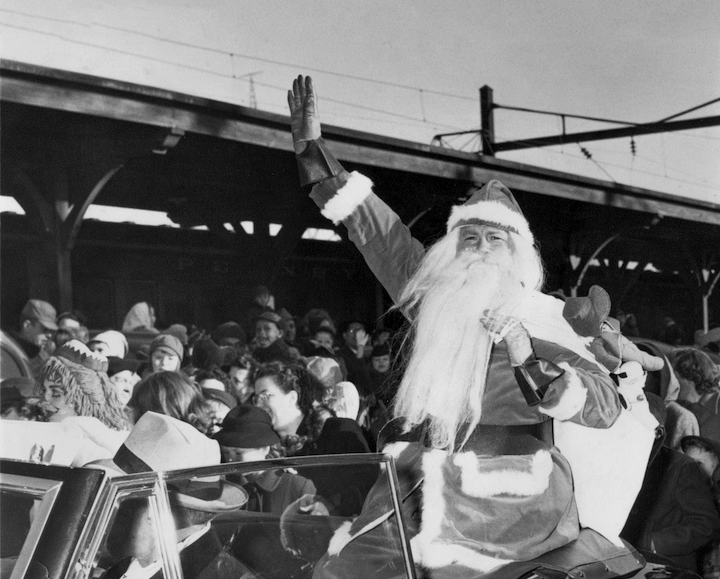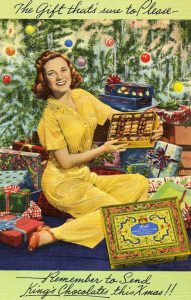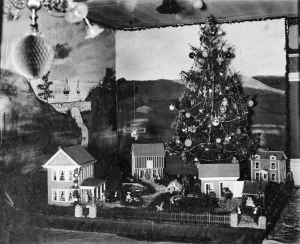Brandywine Stories: Christmas Past in Chester County
Photos courtesy of the Chester County History CenterA little history with your gifts

Each year as the holiday season approaches, our social media feeds and favorite magazines fill with Holiday Gift Guides, showcasing this year’s must-have toy, latest gadgets and trending beauty products. Then on Christmas Day, we gather with our families around the tree unwrapping new toys, clothes and wish-list gifts.
But amid all the gift-giving buzz and holiday bustle, have you taken a moment to think about how gift-giving got to be this way? What’s the history behind this tradition of exchanging presents?
As we do in Brandywine Stories, let’s look into the origins of this holiday tradition.
BSC: Before Santa Claus
Starting in the late 18th century with a look at Christmas Day, we find this celebration was much more understated, free of glitzy decorated trees with mountains of wrapped gifts. Another missing element — there are no children running around with new toys.
Back in the 18th and early 19th centuries, Pennsylvania was a melting pot of cultures and beliefs. Our commonwealth was home to a variety of religious groups, including a strong Quaker presence (Pennsylvania was originally a Quaker colony). Interestingly, several of the early denominations didn’t celebrate Christmas. The Quakers, in particular, believed living more simply allows one to connect more with God, and so they didn’t celebrate Christmas by exchanging material goods.
Even for those groups that did celebrate, Christmas was focused more on adults than children and included religious observances or feasting, drinking and dancing. While neighboring communities like Philadelphia and Lancaster embraced Christmas traditions earlier, Chester County was slow to joining the festivities.
Yet by the 19th and 20th centuries, many holiday customs we share today had made their way into our region.
Top Gifts
In the 19th century, Christmas gifts were generally considered a luxury. If any gifts were exchanged, books and candy topped the list — a more adult-focused list, fitting a more adult-focused celebration. Similarly, early holiday advertisements focused on adults, and books quickly became a favorite gift. Happily for our local independent bookshops, books remain a treasured gift, even today.

Not much of a reader? No worries, those with a sweet tooth would have been in good company during the 19th century holiday season. And in West Chester, the place for sweet treats was run by Mrs. Lydia Ann Pyle, the queen of confections, at her renowned sweetshop on West Gay Street. By December 1877, her shop advertised over a thousand pounds of candy toys molded into shapes like ribbons, insects and trains. Pyle also offered exotic fruits, beautifully packaged as gifts, and was known for her holiday generosity, giving away loaves of bread to those in need.
Phoenixville had its own tradition of holiday candy, which continued in the 1920s. William H. Reeves of the Phoenix Iron Company paid for free candy boxes for over 4,000 local schoolchildren. His legacy lives on even after his death, thanks to a trust fund that continued the sweet tradition.
Santa Claus Comes to Town

The popularity of department stores in the late 19th century forever changed holiday shopping. The concept of one-stop holiday shopping was born, complete with enchanting light displays and holiday music. But more important, these changes brought a beloved holiday figure — Santa Claus.
These changing times also refocused the holiday on children. Advertisements began featuring toys and games, and department stores like Mast’s in Coatesville started promoting tons of toys for kids, from sleds and tricycles to tea sets and books. Mosteller’s Department Store in West Chester embraced the spirit of the season, transforming its third floor into Santa’s Toyland, starting in the 1920s. There, children eagerly lined up to share their Christmas wishes with Santa himself.
By the 1940s, West Chester’s Warren Mercer took on the role of Santa’s helper. He spent most of the year working as a plasterer, but come November, Mercer donned the iconic red suit and climbed a fire truck ladder to Santa’s Toyland at Mosteller’s. And from the third floor, Santa and his elves delighted crowds of excited children.
Today, Mercer’s red suit and letters from hopeful children can be found at the Chester County History Center, preserving a piece of the region’s holiday magic for future generations.
This year, along with your holiday gifts, feel free to share a little history.
Bookplates

The tradition of gifting books for the holidays became so popular in the 19th century that it sparked a demand for bookplates — those decorative labels placed inside the book cover to mark the giver and receiver. Some books even came with built-in bookplate designs printed on the inside flap.
You can still find some of these historical treasures today at area used book stores, such as Baldwin’s Book Barn, complete with personal messages marking their place in history.
For a modern twist, designing — or buying — personalized bookplate adds a special touch to any literary gift you give.
 Jennifer Green, Director of Education at the Chester County History Center, and Sarah Wagner, Outreach Officer for the Chester County Community Foundation, co-wrote this article as part of Chesco250. The Brandywine Stories series is designed to raise awareness to the expansive history and culture of Chester County and build excitement for 2026, the 250th anniversary of the Declaration of Independence.
Jennifer Green, Director of Education at the Chester County History Center, and Sarah Wagner, Outreach Officer for the Chester County Community Foundation, co-wrote this article as part of Chesco250. The Brandywine Stories series is designed to raise awareness to the expansive history and culture of Chester County and build excitement for 2026, the 250th anniversary of the Declaration of Independence.
